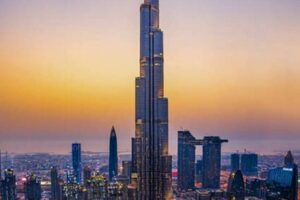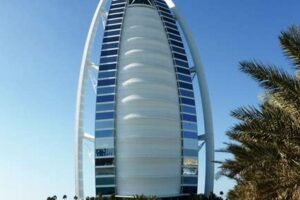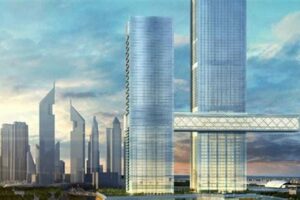Burj Khalifa, formerly known as Burj Dubai, is currently the world’s tallest structure, a high-rise skyscraper in Dubai, United Arab Emirates. It has 162 floors with a height of 829.8 m (2,722 ft). Burj Khalifa was designed by Adrian Smith of Skidmore, Owings & Merrill, and the construction was led by Samsung C&T Corporation. Construction began on 21 September 2004, and the exterior of the building was completed on 1 October 2009. The building was officially inaugurated on 4 January 2010, and it became the tallest structure in the world, surpassing the previous record holder, Taipei 101.
Burj Khalifa is a mixed-use building with residential, commercial, and hospitality spaces. The building contains 900 private residences, 30,000 square meters of retail space, and 15 acres of parkland. It also has the world’s highest observation deck, At the Top, which is located on the 124th floor and offers panoramic views of Dubai.
Burj Khalifa is a symbol of Dubai’s rapid growth and development. It is a major tourist attraction and has been featured in numerous films and television shows. The building has also been praised for its innovative design and engineering.
1. Height
The height of Burj Khalifa is a defining characteristic that sets it apart as the tallest skyscraper in the world. This remarkable feat of engineering has several key implications:
- Architectural Prowess: The height of Burj Khalifa showcases the incredible advancements in architectural design and engineering capabilities. It pushes the boundaries of what is structurally possible, demonstrating the ingenuity and creativity of the architects and engineers involved.
- Global Recognition: As the world’s tallest building, Burj Khalifa has gained international recognition and become an iconic symbol of Dubai’s rapid growth and economic prosperity. Its height contributes to its status as a global landmark and a testament to human ambition.
- Engineering Challenges: Constructing a building of such extraordinary height presented numerous engineering challenges. The architects and engineers had to overcome issues related to structural stability, wind resistance, and efficient elevator systems. The successful completion of Burj Khalifa is a testament to their expertise and dedication.
- Vertical Living: The height of Burj Khalifa has enabled the creation of vertical communities within the building. It accommodates residential apartments, offices, and a hotel, offering a unique urban living experience with breathtaking views and access to a range of amenities.
In summary, the height of Burj Khalifa is not merely a numerical value but a testament to architectural prowess, engineering excellence, and the innovative spirit that drives human progress. It has transformed the Dubai skyline, making it a global icon and a symbol of the city’s ambition and achievements.
2. Architecture
The architecture of Burj Khalifa is a key component of its overall significance and success. The unique Y-shaped design, conceived by Adrian Smith of Skidmore, Owings & Merrill, plays a crucial role in enhancing the building’s structural stability and providing breathtaking views.
The Y-shaped design provides several advantages:
- Structural Stability: The Y-shaped footprint creates three wings that distribute the building’s weight more evenly, reducing stress on the core and foundation. This design allows Burj Khalifa to withstand high winds and seismic activity, ensuring its structural integrity.
- Wind Resistance: The Y-shape helps reduce wind resistance by creating a more streamlined profile. The curved exterior walls deflect wind forces, minimizing sway and vibrations.
- Breathtaking Views: The unique shape of Burj Khalifa allows for floor-to-ceiling windows on multiple sides, providing panoramic views of the surrounding cityscape. The curved balconies further enhance the viewing experience, offering unobstructed vistas from various angles.
The innovative architectural design of Burj Khalifa showcases the exceptional skills and vision of Adrian Smith and his team. It demonstrates how thoughtful design can not only achieve aesthetic appeal but also enhance the functionality and safety of a building.
In conclusion, the architecture of Burj Khalifa, particularly its unique Y-shaped design, is integral to its success as the world’s tallest building. This design ensures structural stability, minimizes wind resistance, and provides breathtaking views, making Burj Khalifa an architectural marvel that continues to captivate and inspire.
3. Mixed-use
The mixed-use nature of Burj Khalifa is a key aspect that distinguishes it from other skyscrapers and contributes to its overall significance. By integrating various functions within a single structure, Burj Khalifa creates a vibrant and self-contained urban environment.
- Vertical Community: Burj Khalifa fosters a sense of community by housing residents, workers, and visitors in a single building. This vertical community promotes social interaction, convenience, and a sense of belonging.
- Economic Hub: The commercial offices and retail spaces within Burj Khalifa create a bustling economic hub. The building accommodates businesses of various sizes, fostering entrepreneurship and economic growth.
- Convenience and Accessibility: The mixed-use design provides residents and visitors with unparalleled convenience. They can access residential, commercial, and hospitality services without leaving the building, enhancing their quality of life.
- Sustainable Design: The mixed-use design promotes sustainable living by reducing the need for transportation and encouraging energy efficiency. Residents and workers can easily access daily necessities within the building, minimizing their carbon footprint.
In conclusion, the mixed-use nature of Burj Khalifa is a testament to its innovative design and forward-thinking approach. By seamlessly integrating residential, commercial, and hospitality functions, Burj Khalifa creates a dynamic and sustainable urban environment that caters to the diverse needs of its occupants and visitors.
4. Observation deck
The observation deck at the top of Burj Khalifa, known as “At the Top,” is a key attraction that contributes to the overall significance of the building. This observation deck offers unparalleled views of Dubai’s skyline, making it a popular destination for tourists and locals alike.
- Tourist attraction: The observation deck attracts a large number of tourists each year, providing them with a unique opportunity to witness the breathtaking views of Dubai from above. This contributes to Dubai’s tourism industry and strengthens its position as a global destination.
- Elevated perspective: The observation deck offers a unique vantage point from which to view the city, allowing visitors to appreciate the scale and grandeur of Dubai’s urban landscape. It provides a different perspective on the city, showcasing its architectural marvels and the vast desert surroundings.
- Architectural showcase: The observation deck itself is an architectural marvel, featuring advanced engineering and design. Its transparent walls and open-air terraces allow visitors to fully immerse themselves in the surrounding views, creating a memorable and awe-inspiring experience.
- Symbol of Dubai: The observation deck has become a symbol of Dubai’s ambition and achievements. It represents the city’s commitment to innovation and its desire to create iconic landmarks that attract global attention.
In conclusion, the observation deck at the top of Burj Khalifa is an integral part of the building’s overall significance. It offers breathtaking views, serves as a popular tourist attraction, provides a unique architectural experience, and embodies Dubai’s spirit of innovation and ambition.
5. Sustainability
In addition to its impressive height and innovative design, Burj Khalifa is also notable for its commitment to sustainability. Despite its size, the building incorporates several sustainable features that contribute to its overall environmental performance.
- Energy efficiency: Burj Khalifa utilizes energy-efficient lighting systems throughout the building, reducing energy consumption and minimizing its carbon footprint. The building also employs a double-skin facade system, which helps to regulate indoor temperatures and reduce the need for artificial cooling and heating.
- Water conservation: Burj Khalifa has implemented a comprehensive water conservation system that includes low-flow fixtures, rainwater harvesting, and a greywater recycling system. These measures help to reduce the building’s water consumption and contribute to the preservation of Dubai’s precious water resources.
- Waste management: Burj Khalifa has implemented a comprehensive waste management program that includes waste sorting, recycling, and composting. This program helps to reduce the amount of waste sent to landfills and promotes sustainable waste management practices.
By incorporating these sustainable features, Burj Khalifa demonstrates its commitment to environmental responsibility and sets a positive example for other buildings in the region. These features contribute to the building’s overall sustainability and help to reduce its impact on the environment.
6. Tourism
Burj Khalifa’s status as a major tourist attraction is closely intertwined with its architectural marvel. The building’s impressive height, innovative design, and unique features have made it a must-visit destination for tourists from around the world.
The connection between tourism and Burj Khalifa is mutually beneficial. The building’s iconic status attracts tourists, who contribute to Dubai’s economy and help to raise the city’s profile as a global destination. In turn, tourism provides a financial incentive for the continued maintenance and preservation of Burj Khalifa, ensuring that it remains a symbol of Dubai’s architectural prowess for years to come.
The practical significance of understanding this connection lies in recognizing the importance of investing in iconic architecture as a means of boosting tourism and economic growth. Burj Khalifa serves as a successful example of how a bold architectural vision can transform a city into a major tourist destination.
7. Symbol of Dubai
The connection between “Symbol of Dubai: Burj Khalifa stands as an iconic symbol of Dubai’s rapid growth and economic prosperity” and “skyscraper Burj Khalifa” lies in the building’s profound significance as a representation of Dubai’s remarkable transformation and economic success.
Burj Khalifa’s iconic status stems from its record-breaking height and innovative design, making it a globally recognized architectural marvel. Its construction was a bold and ambitious undertaking, reflecting Dubai’s aspirations for economic growth and global recognition. The building’s completion in 2010 coincided with a period of rapid economic expansion in Dubai, further solidifying its status as a symbol of the city’s prosperity.
The practical significance of understanding this connection lies in recognizing the power of iconic architecture to drive economic development and promote national pride. Burj Khalifa has become a major tourist attraction, drawing visitors from around the world eager to witness its architectural grandeur. This influx of tourism has a positive impact on Dubai’s economy, creating jobs and stimulating various sectors, including hospitality, retail, and transportation.
Moreover, Burj Khalifa’s symbolic value has extended beyond Dubai, becoming a symbol of the broader Middle East region’s growing economic power and architectural innovation. It has inspired other ambitious construction projects throughout the region, contributing to a positive perception of the Middle East as a hub for architectural excellence and economic growth.
In conclusion, the connection between “Symbol of Dubai: Burj Khalifa stands as an iconic symbol of Dubai’s rapid growth and economic prosperity” and “skyscraper Burj Khalifa” is multifaceted and profound. Burj Khalifa’s iconic status is a reflection of Dubai’s economic success and global aspirations, while its architectural marvel has become a driver of economic growth and a source of national pride, both for Dubai and the wider Middle East region.
8. Global recognition
The global recognition of Burj Khalifa, as depicted in numerous films and media, is inextricably linked to its architectural prowess and iconic status as “skyscraper burj dubai.” This recognition has several facets that contribute to the significance of both the building and Dubai’s architectural landscape:
- Cultural Symbolism: Burj Khalifa’s distinctive silhouette and record-breaking height have made it a cultural icon, representing Dubai’s ambition, modernity, and architectural ingenuity. Its presence in films and media reinforces this symbolism, projecting an image of Dubai as a global architectural hub.
- Tourism Magnet: The building’s global recognition has contributed to its status as a major tourist attraction, drawing visitors from around the world eager to witness its architectural grandeur. Films and media featuring Burj Khalifa showcase its stunning design and views, further fueling its appeal as a must-visit destination.
- Architectural Inspiration: Burj Khalifa’s innovative design and engineering solutions have inspired architects and engineers worldwide. Its prominence in films and media serves as a platform for showcasing these advancements, stimulating new ideas and mendorong innovation in the field of architecture.
- Global Identity: Burj Khalifa has become synonymous with Dubai’s identity on a global scale. Its frequent depiction in films and media reinforces Dubai’s position as a modern, cosmopolitan city and a center for architectural excellence.
In conclusion, the global recognition of Burj Khalifa through films and media is not merely a reflection of its architectural achievement but also a testament to its profound impact on Dubai’s cultural identity and global perception. Burj Khalifa has transcended its status as a building to become a symbol of architectural prowess, inspiring innovation, attracting tourism, and solidifying Dubai’s position as a global architectural destination.
Frequently Asked Questions about Burj Khalifa
This section addresses common questions and misconceptions surrounding Burj Khalifa, providing informative answers to enhance understanding of this architectural marvel.
Question 1: What is the height of Burj Khalifa?
Burj Khalifa stands at an impressive height of 829.8 meters (2,722 feet), making it the tallest building in the world.
Question 2: How many floors does Burj Khalifa have?
Burj Khalifa has 162 floors above ground, offering breathtaking views from its observation decks.
Question 3: What is the primary purpose of Burj Khalifa?
Burj Khalifa is a mixed-use building, housing residential apartments, commercial offices, a hotel, and retail spaces, creating a vibrant vertical community.
Question 4: Is Burj Khalifa an environmentally friendly building?
Yes, Burj Khalifa incorporates sustainable features such as energy-efficient lighting, a water conservation system, and waste management practices to minimize its environmental impact.
Question 5: Can tourists visit Burj Khalifa?
Yes, tourists can visit Burj Khalifa’s observation deck, “At the Top,” which offers panoramic views of Dubai’s skyline from the 124th floor.
Question 6: What is the architectural significance of Burj Khalifa?
Burj Khalifa showcases innovative design and engineering, featuring a Y-shaped footprint for structural stability, a double-skin facade for energy efficiency, and advanced wind-resistant technologies.
These questions and answers provide a comprehensive overview of Burj Khalifa, addressing its height, purpose, sustainability, tourism accessibility, and architectural significance.
Tips for Visiting Burj Khalifa
Visiting Burj Khalifa, the world’s tallest building, can be an awe-inspiring experience. To make the most of your visit, consider the following tips:
Tip 1: Book Tickets in Advance
Burj Khalifa’s observation deck, “At the Top,” is a popular tourist attraction. To avoid long queues and secure your preferred time slot, book your tickets online in advance.
Tip 2: Choose the Right Time to Visit
For the best views, visit during the golden hour (sunrise or sunset) or at night when the city lights up. However, if you prefer a quieter experience, consider visiting during off-peak hours.
Tip 3: Allow Ample Time
Exploring Burj Khalifa takes time. Allow at least 2-3 hours for security checks, elevator rides, and enjoying the observation deck. If you plan to visit during peak hours, allocate additional time.
Tip 4: Dress Appropriately
The observation deck can be chilly, so dress in comfortable, layered clothing. Also, wear closed-toe shoes as there is some walking involved.
Tip 5: Capture Memorable Photos
Burj Khalifa offers breathtaking views. Bring a camera to capture the stunning vistas from the observation deck. Use a wide-angle lens to fit the entire structure in your frame.
Tip 6: Explore the Surroundings
Burj Khalifa is located in Downtown Dubai. Take some time to explore the surrounding area, which offers world-class shopping, dining, and entertainment options.
Tip 7: Consider a Guided Tour
Guided tours of Burj Khalifa provide insights into the building’s history, architecture, and engineering. Tours are available at an additional cost and can be booked in advance.
Summary:
By following these tips, you can maximize your visit to Burj Khalifa and create lasting memories of this architectural marvel. Remember to book your tickets early, choose the right time to visit, allow ample time, dress appropriately, capture memorable photos, explore the surroundings, and consider a guided tour for an enhanced experience.
Conclusion
Burj Khalifa, once known as Burj Dubai, stands as a testament to human ambition and architectural prowess. Its journey from concept to completion is a story of innovation, engineering excellence, and unwavering determination. As the world’s tallest building, Burj Khalifa has redefined the limits of architectural possibility and become an iconic symbol of Dubai’s rapid growth and economic prosperity.
The building’s unique design, sustainable features, and mixed-use functionality make it a marvel of modern architecture. Its observation deck offers breathtaking panoramic views of Dubai, attracting tourists from around the globe. Burj Khalifa has not only transformed Dubai’s skyline but has also inspired countless architectural projects worldwide, showcasing the power of human imagination and the drive to reach new heights.







